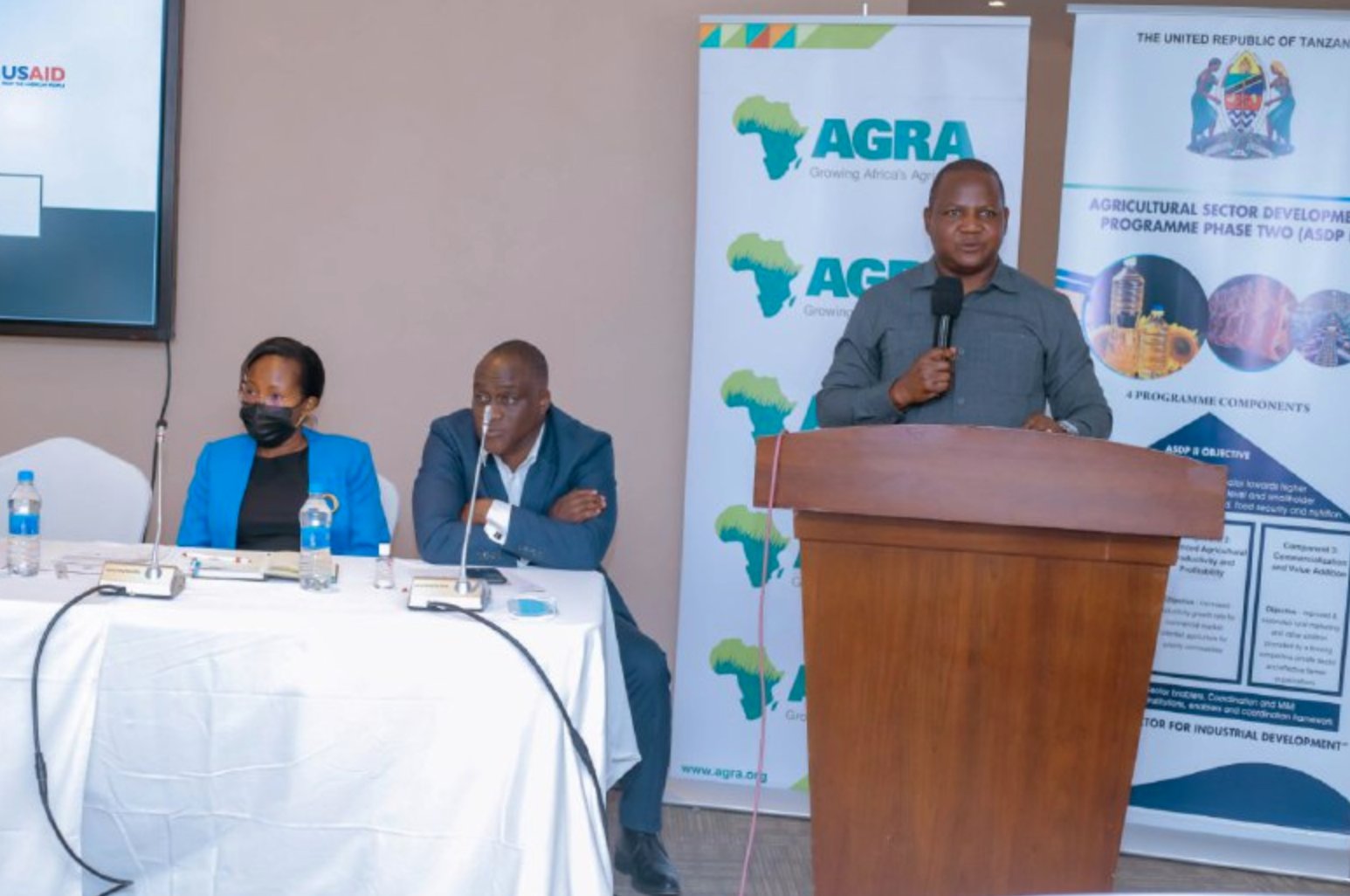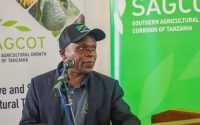Tanzania’s Agricultural Renaissance under President Samia Suluhu Hassan: A Three-Year Review with SAGCOT, NFRA, and TAHA
Kilimokwanza.org Team
On Friday, March 15, 2024, Sam Sasali, a distinguished journalist and editor at Clouds Media Group, initiated a thought-provoking discussion reflecting on the impactful three-year tenure of President Dr. Samia Suluhu Hassan.
Accompanying him were: Geoffrey Kirenga, the CEO of the Southern Agricultural Growth Corridor of Tanzania (SAGCOT), who plays a key role in spearheading agricultural development in the southern corridor of the country, and Dr. Andrew Komba, the Director General of the National Food Reserve Agency (NFRA) and ANTHONY CHAMANGA, Chief Manager (Development) at the Tanzania Horticultural Association (TAHA). This engaging conversation was designed to illuminate the strides and advancements achieved during the Honorable President’s leadership. Sasali aimed to delve into lesser-known or potentially overlooked aspects of President Suluhu Hassan’s administration, especially concerning the progress and activities within the agricultural domain and food security.
Setting the stage for an enlightening exchange, Sasali turned to Mr. Geoffrey Kirenga with an inquiry that sought to unpack the essence of SAGCOT: its primary objectives, operational breadth, and the geographic expanse it encompasses.
Geoffrey Kirenga shared:
SAGCOT stands for the Southern Agriculture Growth Corridors of Tanzania. In Tanzania, we’ve divided the country into seven agricultural zones. Beyond these zones, there are specific areas we refer to as agricultural ‘corridors’. One key corridor is the Southern Highlands Corridor, previously known as the Big 5, responsible for producing nearly 65% of the nation’s food, effectively making it Tanzania’s breadbasket. Additionally, we have other corridors like the Mtwara Corridor and the Central Corridor, which follows the central railway, and the Northern Corridor, covering the regions of Arusha, Manyara, and Kilimanjaro. Each area presents unique agricultural opportunities.
About a decade ago, we initiated efforts to foster investments, particularly those involving the private sector in partnership with the government, focusing on this critical food production area. I will share more about the accomplishments and the extensive work done in this segment shortly. Initially, this area was not as well-known compared to the northern regions or the Lake Zone. However, today, when discussing agriculture, it’s evident that significant efforts are underway here.
In light of this, on March 17 last year, the Honorable President Samia Suluhu Hassan directed that the initiatives undertaken in this corridor be expanded across the country to other corridors. Hence, we are in the process of extending the successful strategies of SAGCOT to additional areas. In our future discussions, we might not only refer to SAGCOT but to the Agriculture Growth Corridors of Tanzania (AGCOT), indicating that SAGCOT is transitioning into AGCOT. This signifies the broadening of agricultural corridors throughout Tanzania.
SAM SASALI: Chamanga, what exactly is TAHA and what are TAHA’s core responsibilities?
ANTHONY CHAMANGA, Chief Manager (Development) at the Tanzania Horticultural Association (TAHA)
TAHA, which stands for the Tanzania Horticultural Association, is the apex private sector organization involved in the development of the horticulture industry in Tanzania. Our work encompasses a range of activities, including ensuring sufficient production of horticultural crops. By horticulture, I mean fruits, vegetables, flowers, spices, and seeds of these crops. We also connect farmers with markets that ultimately enable them to earn higher incomes. The domestic market is vast, and Sam, just so you know, over 90% of the horticultural produce grown in Tanzania is consumed domestically. Thus, the local market is not only large but also the most crucial. Additionally, we link farmers with regional markets and international markets. We also work with the government to provide accurate information for making informed decisions based on various policies and regulations. We’re involved in building various infrastructures, especially for marketing but also for irrigation. TAHA has a nationwide presence, with our headquarters in Arusha, but we operate across the entire country, including Zanzibar.
SAM SASALI: Dr. Andrew Komba, for someone hearing about NFRA for the first time, they might wonder if it’s related to agriculture, railways, or something else… What exactly is NFRA?
NFRA stands for the National Food Reserve Agency, meaning it is the national agency responsible for food storage. As a government agency, NFRA’s primary function is to purchase and store food, specifically for use during times of food scarcity. When there is a shortage of food within the country, it is NFRA’s duty to release the stored food into the market to ensure that no Tanzanian goes hungry due to a lack of food.
Additionally, we engage in another task, Sam, which involves recycling or rotating the stored food. This means that after a certain period, according to policy, which is after three years, the food must be released back into the market because it remains of good quality. So, we sell this food, but we don’t use the term ‘sell’ in the sense of seeking profit. Instead, it’s done with the intention of ensuring that citizens have access to this food. Currently, we store maize, rice, and sorghum. These foods are selected because they are staples in the Tanzanian diet. So, if any Tanzanian is hungry, providing them with maize, rice, or sorghum will suffice. For now, we are focusing on these, but we are also planning to include other foods in our storage.
NFRA’s role is to ensure that the country does not experience hunger at all. Since its establishment by law in 2008 and following revisions made in 2016, we have never failed to keep Tanzania free from hunger. Therefore, food is available and has been increasing day by day.
SAM SASALI: Let’s turn back to you, Mr. Geoffrey Kirenga. In the three years that the Honorable President has been in office, can you share with us some of the achievements you’ve made, so that when we come back to discuss this next year, we’re not just talking about the southern Corridors but all the corridors in Tanzania? What has happened in these three years?
Mr. Geoffrey Kirenga
Thank you very much, Sam, for that excellent question. It’s precisely the kind of question that we, who are in the agricultural sector and especially those of us working with farmers, appreciate. There has been a significant closeness between the government and the private sector, so the government has provided more opportunities and space for the private sector to invest in agriculture. A good example I’d like to use is that for many years, we’ve been saying that sales and trade in agriculture are increasing. A major indicator, which is very important, is that our exports now bring in about twice as much revenue as they did in previous years for this period.
We’ve gone from an average of 1 to 1.2 billion dollars to now reaching 2.3 billion dollars, which is a significant indication that our sector is growing. Another point I’ve been discussing is the closeness between the government and the private sector, meaning there are discussions and dialogues aimed at removing obstacles that make it difficult for the private sector. So, legal issues, policies, regulations, and procedures have seen such obstacles removed, simpler laws have been put in place, tax issues have been reduced in areas that were problematic, but most importantly, the government sits down and talks with the private sector. This doesn’t just happen at the national level but also at the regional and district levels. Within SAGCOT, we have what are called cluster meetings, where stakeholders in agriculture meet with government leaders in their areas to discuss what is hindering the private sector’s growth, what they need the government to do. From those discussions, it becomes clear what needs to be done, for example, if you’ve invested in agriculture, you need electricity to reach your business area, electricity arrives, you need roads in your area so you can transport tea, milk, fruits. Currently, as our colleague from TAHA would tell you, crops like avocados are being developed extensively, but there are also vegetables and other produce like carrots, cabbages that need to move from rural areas to urban centers. So, when you see the work done by Tarula, it’s based on discussions like these, all of which are very important for agriculture.
But also, the issue of bringing technology, fertilizers, seeds, and pesticides, which are essential to ensure increased productivity, the greatest opportunity that has been found is to make a contribution and provide a significant opportunity that the private sector offers, but most importantly, is how the government invests in policy matters.
SAM SASALI: Mr. Anthony, when we talk about vegetables, fruits, we’re talking about the daily life of a Tanzanian – you can have a fruit in the morning, afternoon, evening. But the demand is increasing because the population is growing, and the need for horticultural food products is also significantly rising. Every time you go to a hotel, a celebration, and as Prof Janabi continues to speak, we’re nurturing the horticulture sector. How can you discuss this in terms of business and production over these three years?
ANTHONY CHAMANGA
First, I want to take this opportunity to express my gratitude to the government for giving us a greater role in this three-year period. It has allowed us to work closely with the government; we’ve managed to sign a Memorandum of Understanding with the Ministry of Agriculture. Through this document, we’ve accomplished a lot. In these three years, we’ve seen an increase in the production of horticultural crops. Three years ago, production was at 6.9 million tons, approaching 7 million tons per year, but now, production exceeds 7.3 million tons.
There’s an issue that isn’t often discussed, Sam. Horticulture also plays a significant role in food security. Looking at the food security basket, all crops combined, like maize, sorghum, rice, and others, amount to about 17 million tons. Of these 17 million tons, 17% is contributed by horticultural crops, which include potatoes and bananas, amounting to more than 3 million tons per year.
So, in this period of three years, we’ve witnessed horticulture continuing to contribute more to the food security basket. And as you’ve mentioned, we observe the daily increasing consumption of horticultural products like fruits and vegetables at an even faster pace, not just as part of a meal but as special foods. Nowadays, someone might say, “OK, I will eat more bananas,” and just the other day, we heard the Honorable President emphasizing the importance of taking care of our health, eating well, etc., and these horticultural products play a significant role. Another thing we’ve done in these three years is greatly open up markets, especially regional markets and markets outside Africa.
Video, courtesy of Clouds Media


